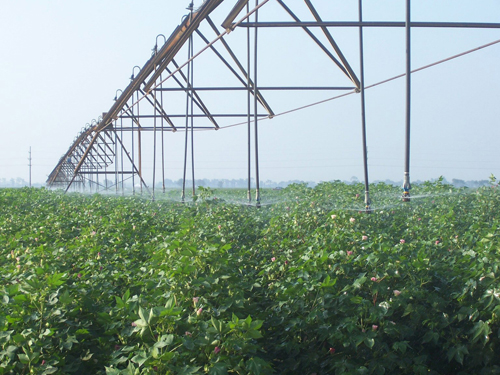A recent University of Georgia report shows that Georgia farmers will need 20 percent more water to grow their crops in the next four decades. They’ll need it to meet increased food demand and to compete globally.
“Without irrigation, in many places, there is no farming,” said Jim Hook, a professor with the UGA College of Agricultural and Environmental Sciences. “And for many regions of the state, agriculture is still the best economic bet for growth.”
The Georgia Environmental Protection Division commissioned the report, which was produced by a team of UGA crop and weather experts. Its purpose is to provide information to the state’s regional water councils meeting throughout the state this month, said Hook, who is the team’s leader.
The councils will consider the report as they develop water plans for their regions, which will then be added to the overall state water plan. The state plan will also include forecasts for population and economy, energy use, land use and water and wastewater demands.
The forecast predicts the water farmers will need to irrigate pecans and major row crops like cotton, peanuts, corn and soybeans, which account for 85 percent of the current irrigation needs. Vegetables, orchards, blueberries, sod farms and nurseries were also included. It specifies whether the water will come from groundwater (underground water) or surface water (water from ponds, rivers or streams).
It includes how much water farmers will need in a dry, average or wet year. In Georgia, Mother Nature can be a bit mischievous in when and where rainfall hits.
“In Western states, it’s easier to know how much water you have each year. It’s either collected in reservoirs or stored as mountain icecaps,” Hook said. “That’s not the case in Georgia, where recharge is less predictable.”
For example, if 2011 is a dry year from spring through fall, farmers will need 800 million gallons of water per day from underground sources and 300 million gallons per day from surface sources, according to the forecast. If 2050 is a dry year, they will need 1 billion gallons per day from underground sources and 400 million gallons per day from surface water.
“Georgia’s agriculture sector will continue to be a major water user in the state,” he said.
The forecast is broken down by water planning regions, counties, river basins and sub-basins. The county data includes monthly water demands, crop projections and current irrigated fields.
Existing computer models were used to make the forecast, he said, which took 9 months to complete.
Economic models from the U.S. Department of Agriculture were used to predict farmers’ crop choices over the next decade, focusing particularly on farmers in the Southeast. Crop models developed by CAES researchers were used to foretell crop water needs and climate data.
Geographical Information System, or GIS, images were used to locate the 23,000 fields in Georgia that have irrigation systems, including more than 15,000 center pivots, or large systems that rotate in a field.
Future irrigation use will happen in places where the practice is already established, particularly in southwest Georgia, the state’s row-crop and vegetable production hub. The area’s water needs are fueled by one of the largest water supplies in the country: the Floridan aquifer. It starts near the state’s fall line and runs east into extreme southern South Carolina and south through Florida.
“The Floridan is a massive water supply,” Hook said.
The aquifer is recharged by water that falls in south Georgia, he said. Its levels are not connected to any rainfall or use in north Georgia, where water comes from surface water supplies that don’t make it into the aquifer.
Irrigation use exploded in 1970s and ‘80s in Georgia, when irrigated acres jumped from 200,000 acres to 1 million acres, he said. Since then, it has been a steady increase to the 1.5 million irrigated acres today.
It is estimated that farmers have invested almost $3 billion in today’s dollars in irrigation equipment and infrastructure in the state over the past four decades, he said, an investment that is responsible for much of the $3 billion to $4 billion in annual crop sales in Georgia.
To view the entire forecast, visit www.nespal.org/sirp/waterinfo/state/awd/agwaterdemand.htm.








